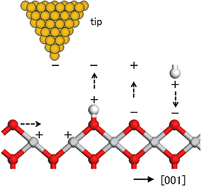Crossref Citations
This article has been cited by the following publications. This list is generated based on data provided by
Crossref.
Minato, Taketoshi
Asao, Naoki
Yamamoto, Yoshinori
Kawai, Maki
and
Kim, Yousoo
2013.
Photoresponse on the Desorption of an Atomic Hydrogen on Titanium Dioxide Surface Induced by a Tip of Scanning Tunneling Microscope.
Chemistry Letters,
Vol. 42,
Issue. 8,
p.
942.
Irfan, Ahmad
2013.
Quantum chemical investigations of electron injection in triphenylamine-dye sensitized TiO2 used in dye sensitized solar cells.
Materials Chemistry and Physics,
Vol. 142,
Issue. 1,
p.
238.
Setvin, Martin
Daniel, Benjamin
Aschauer, Ulrich
Hou, Weiyi
Li, Ye-Fei
Schmid, Michael
Selloni, Annabella
and
Diebold, Ulrike
2014.
Identification of adsorbed molecules via STM tip manipulation: CO, H2O, and O2 on TiO2 anatase (101).
Phys. Chem. Chem. Phys.,
Vol. 16,
Issue. 39,
p.
21524.
Minato, Taketoshi
2014.
Atomic Defects in Titanium Dioxide.
The Chemical Record,
Vol. 14,
Issue. 5,
p.
923.
Minato, Taketoshi
Kajita, Seiji
Pang, Chi-Lun
Asao, Naoki
Yamamoto, Yoshinori
Nakayama, Takashi
Kawai, Maki
and
Kim, Yousoo
2015.
Tunneling Desorption of Single Hydrogen on the Surface of Titanium Dioxide.
ACS Nano,
Vol. 9,
Issue. 7,
p.
6837.
Zhang, Zhen
and
Yates, John T.
2015.
Defects at Oxide Surfaces.
Vol. 58,
Issue. ,
p.
81.
Pang, Chi Lun
and
Thornton, Geoff
2015.
Defects at Oxide Surfaces.
Vol. 58,
Issue. ,
p.
429.
Jang, Moon Hyung
Agarwal, Rahul
Nukala, Pavan
Choi, Dooho
Johnson, A. T. Charlie
Chen, I-Wei
and
Agarwal, Ritesh
2016.
Observing Oxygen Vacancy Driven Electroforming in Pt–TiO2–Pt Device via Strong Metal Support Interaction.
Nano Letters,
Vol. 16,
Issue. 4,
p.
2139.
Faber, Katherine T.
Asefa, Tewodros
Backhaus‐Ricoult, Monika
Brow, Richard
Chan, Julia Y.
Dillon, Shen
Fahrenholtz, William G.
Finnis, Michael W.
Garay, Javier E.
García, R. Edwin
Gogotsi, Yury
Haile, Sossina M.
Halloran, John
Hu, Juejun
Huang, Liping
Jacobsen, Steven D.
Lara‐Curzio, Edgar
LeBeau, James
Lee, William E.
Levi, Carlos G.
Levin, Igor
Lewis, Jennifer A.
Lipkin, Don M.
Lu, Kathy
Luo, Jian
Maria, Jon‐Paul
Martin, Lane W.
Martin, Steve
Messing, Gary
Navrotsky, Alexandra
Padture, Nitin P.
Randall, Clive
Rohrer, Gregory S.
Rosenflanz, Anatoly
Schaedler, Tobias A.
Schlom, Darrell G.
Sehirlioglu, Alp
Stevenson, Adam J.
Tani, Toshihiko
Tikare, Veena
Trolier‐McKinstry, Susan
Wang, Hong
and
Yildiz, Bilge
2017.
The role of ceramic and glass science research in meeting societal challenges: Report from an NSF‐sponsored workshop.
Journal of the American Ceramic Society,
Vol. 100,
Issue. 5,
p.
1777.
Mellor, Andrew
Humphrey, David
Yim, Chi M.
Pang, Chi L.
Idriss, Hicham
and
Thornton, Geoff
2017.
Direct Visualization of Au Atoms Bound to TiO2(110) O-Vacancies.
The Journal of Physical Chemistry C,
Vol. 121,
Issue. 44,
p.
24721.
Minato, Taketoshi
and
Abe, Takeshi
2017.
Surface and interface sciences of Li-ion batteries.
Progress in Surface Science,
Vol. 92,
Issue. 4,
p.
240.
Zhang, Quanzhen
Wen, Huan Fei
Adachi, Yuuki
Miyazaki, Masato
Sugawara, Yasuhiro
Xu, Rui
Cheng, Zhi Hai
and
Li, Yan Jun
2019.
Electrical Engineering of the Oxygen Adatom and Vacancy on Rutile TiO2(110) by Atomic Force Microscopy at 78 K.
The Journal of Physical Chemistry C,
Vol. 123,
Issue. 47,
p.
28852.
Mofokeng, Thapelo Prince
Ipadeola, Adewale Kabir
Tetana, Zikhona Nobuntu
and
Ozoemena, Kenneth Ikechukwu
2020.
Defect-Engineered Nanostructured Ni/MOF-Derived Carbons for an Efficient Aqueous Battery-Type Energy Storage Device.
ACS Omega,
Vol. 5,
Issue. 32,
p.
20461.
Adachi, Yuuki
Sugawara, Yasuhiro
and
Li, Yan Jun
2020.
Remotely Controlling the Charge State of Oxygen Adatoms on a Rutile TiO2(110) Surface Using Atomic Force Microscopy.
The Journal of Physical Chemistry C,
Vol. 124,
Issue. 22,
p.
12010.
Gurylev, Vitaly
2021.
Nanostructured Photocatalyst via Defect Engineering.
p.
103.
Minato, Taketoshi
Umeda, Kenichi
Kobayashi, Kei
Araki, Yuki
Konishi, Hiroaki
Ogumi, Zempachi
Abe, Takeshi
Onishi, Hiroshi
and
Yamada, Hirofumi
2021.
Atomic-level nature of solid/liquid interface for energy conversion revealed by frequency modulation atomic force microscopy.
Japanese Journal of Applied Physics,
Vol. 60,
Issue. SE,
p.
SE0806.
Braz, Danilo C.
Alves Junior, C.
Vitoriano, Jussier de O.
Rocha, Hugo A.
Biscaia, Stelle M.P.
Franco, Célia R.C.
and
Moura, Carlos E.B.de
2022.
Effect of the ratio of oxygen to nitrogen on the physicochemical and biocompatibility properties of titanium oxynitride.
Materials Chemistry and Physics,
Vol. 278,
Issue. ,
p.
125508.
Huang, Zhiquan
Li, Zhongshu
Zhang, Xiyu
Zhang, Zhongxing
and
Chen, Jian
2023.
(0 0 1) Facets optimized surface oxygen vacancies in TiO2 films to enhance photocatalytic antibacterial and hydrophilic properties.
Applied Surface Science,
Vol. 616,
Issue. ,
p.
156571.
Ikeda, Yoshitaka
Minami, Susumu
and
Shimada, Takahiro
2024.
Emergent local negative electrostriction induced by oxygen vacancy in BaHfO3: Defect engineering.
Journal of Applied Physics,
Vol. 136,
Issue. 21,
Wang, Wenxing
Hou, Qingyu
and
Guo, Shaoqiang
2024.
Effects of Oxygen Vacancies with Different Valence States on the Photo(electro)catalytic Performance of a 2D TiO2:N (001) System.
ACS Sustainable Chemistry & Engineering,
Vol. 12,
Issue. 23,
p.
8820.
